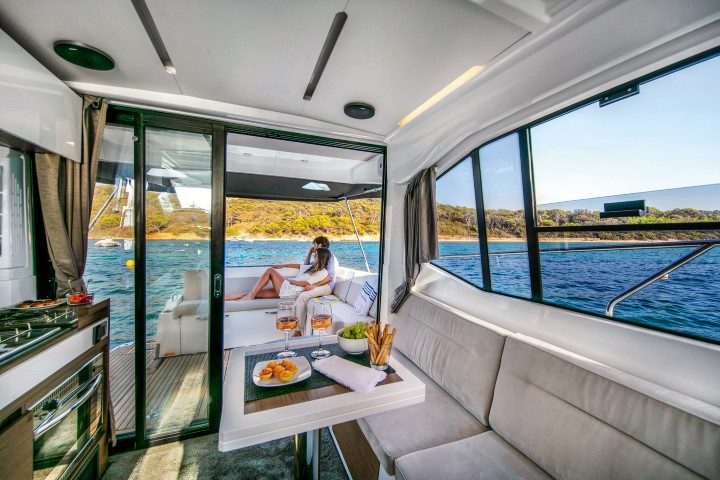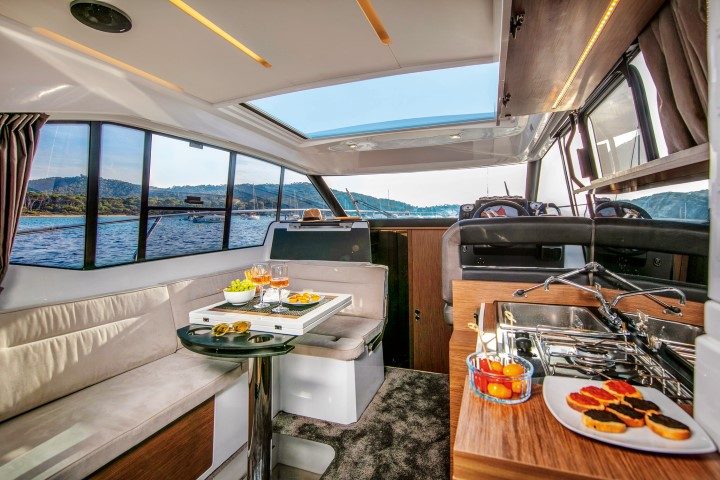She feels really easy and comfortable to sail, even in a good breeze and a chop.
- A rewarding drive with decent performance
- Stylish lines and clever utilisation of space
- Good indoor-outdoor flow
- Single level living
- Well priced
Jeanneau’s feature-packed NC 33 delivers versatility, functionality and performance in a stylish package that’s remarkably affordable, even with the New Zealand dollar’s current weakness against the Euro.
The NC 33 (33 feet, 34 feet 5 inches overall) is the first of a new generation of NC motoryachts. It features a slippery new hull design by Michael Peters that shares DNA with Jeanneau’s Leader range and a new naming convention, in feet, to make it more accessible to North American buyers.
With a deeper vee than the rest of the NC range and a steep-ish forefoot, the new NC 33 should easily cope with any sea conditions it encounters in the Hauraki Gulf. It is also a dry runner, thanks to a bit of bow flare, while above the chines the hull carries plenty of volume through its length to maximise accommodation in the forward cabin.

The newest NC shares many of the features that have made other models in the NC range so popular, including the sliding transom module. When it’s in the forward position, there’s space on the swim platform to accommodate a small RIB tender and plenty of room for swimming; with the transom in the aft position, the cockpit benefits from more space.
In the cockpit, the L-shaped rear seats can be configured in different ways, including a sun lounger, while the moulded transom module offers useful locker storage for fenders, assorted bulky items and a hot and cold shower. It’s accessed from the swim platform, as is the separate locker for the shore power socket and lead.

Orakei Marine supplies a swim platform bait board on a stainless-steel staple as standard equipment. It was fitted a few days after our review.
The saloon table can also be shifted into the cockpit and there’s another (optional) sun lounger on the foredeck with adjustable backrests and cushions that don’t hold water. There are plenty of drink holders on the bow, next to the helm and everywhere else aboard the boat.
One of the nice things about the NC range, including the new 33, is the flush deck from the cockpit to the companionway stairs. Single-level living really blurs the distinction between cockpit and saloon, aided by the NC 33’s clever three-way sliding doors which can be secured on either side: slide them to starboard and the saloon and cockpit seating areas merge into one; slide them to port and the aft galley is accessible from the cockpit.

The galley is compact, the sink and two-burner gas cooker (electric optional) hidden away under a lid that serves as the counter top. There’s an under-bench oven, a rubbish bin and a bit of drawer storage, plus overhead cabinets for crockery.
In some previous NC models, while the small fridge under the helm seat was adequate for day trips, refrigerated space was definitely at a premium on longer cruises. With the NC 33, Jeanneau has addressed this by adding a second refrigerator in the companionway, doubling fridge capacity. It is supplemented by a pantry/storage area with handy organiser shelves and there’s additional space for stores under the saloon sole.

The saloon is a good size for a 10m boat, the impression of space accentuated by deep-waisted windows, a one-piece windscreen (two washer-wipers) narrow windscreen mullions and a pair of sliding tempered glass sunroof panels. A single, full-width Webasto electric roof panel is an option.
The roof panels are not the only things that slide. As well as the rear doors, there’s a sliding window on the port side and a starboard side-door opening to the side-deck, for stress-free docking.
Like some other French designs, the NC 33’s superstructure is offset so that the starboard side-deck is wider than the port side. That makes starboard the obvious route to the bow, either from the cockpit or from the helm via the side door.
With twin duo-prop sternlegs and a bowthruster, this is an easy vessel to dock with a shorthanded crew. A small bulwark door on the starboard side makes stepping aboard easier too.
Like the cockpit, seating in the saloon is L-shaped, along the port side, with a reversible backrest at the front so you can also face forward when the boat’s underway – there’s a handy grab rail across the front of the dashboard. The saloon table is relatively narrow but has foldable leaves to double its length. A berth conversion kit is an option to create an extra double berth in the saloon.
Jeanneau has made good use light and dark walnut alpi timber finishes on the floors, cabinetry and trim, as well as judicious use of vinyl coverings and accents rather than exposed gelcoat. The interior incorporates contrasting light and dark timbers and fabrics, which combined with big windows and openings, helps creates a stylish, light-filled space.

There is a similar feel below decks where two cabins can accommodate four adults in comfort. The bow cabin has an almost-island berth with excellent storage under the bed, plus access to the water pump. A feature of the berth is its pull-out foot section, extending its length to over two metres.
There’s good headroom inside the cabin and by using a sliding cavity door, the cabin doesn’t sacrifice useable space to a swinging door. A hanging locker, white laminate cupboards around the upper level and shelf space complete the storage options.
The guest cabin has a queen-size double tucked under the saloon across the beam so standing headroom is limited to just inside the door next to the hanging locker. There’s standing room for dressing, though, and both cabins have seats to sit on when pulling on your shoes.
As well as the hanging locker, storage is provided at the foot of the berth and in an additional locker. There’s also space under the bed for spare parts or bags.
Both cabins benefit from light through the side windows and overhead hatches (insect screens and blackout screens are standard), but the forward cabin is better lit. The hull is reportedly very quiet at anchor, with no slapping, which promotes a restful night’s sleep.

This vessel has a single shared bathroom, which is large for boat of its length, with a vanity and separate shower stall that also houses the toilet.
Power for the standard NC 33 is a pair of Volvo Penta D3 220hp diesels. These 2.4-litre, five-cylinder, variable-vane turbo-charged units drive the boat through a pair of duo-prop sternlegs to a top speed of around 32 knots. Cruise speed is anywhere between 20 and 25 knots. On a recent weekend cruise, the boat burned 30 litres per hour per engine travelling at 25 knots, which was the optimum speed in the conditions. At 21 knots, range from the 520-litre tank is around 207 nautical miles with a 10% fuel reserve.
These are compact engines, so they fit easily under the cockpit sole with plenty space around them in the engine room. Options for this model include a genset and air-conditioning.
The driving experience is a good one. The NC 33 has quite sporty handling with excellent response and strong acceleration. She answers the helm instantly, heeling over modestly and tracking true. A little down trim on the tabs controls the bow lift while a little trim-out on the legs gives the best cruising performance.

The helm position is nicely sorted, whether you are standing up to drive or sitting down. You have a choice of two elevated platforms to stand on, one higher than the other, which also double as steps out through the side door onto the side deck, a clever touch.
The console layout works well ergonomically. Rocker switches are easy to reach, large tachometers left and right keep you abreast of engine revolutions and there’s a row of Volvo analogue gauges across the top of the console.
The main feature of the console is the Raymarine MFD, which sits in the centre. There’s enough real estate for a 19-inch display and space on the lower tier for optional autopilot and depth gauges, bowthruster control and drink holders. Steering is hydraulic and the wheel can be adjusted for height while the digital throttle and shift controls just inside the side door are effortless and precise. Joystick control is another option.
Anchor duties can be undertaken from the helm – a stainless Danforth-style kedge anchor secured on the short bowsprit/fairlead is standard. A Maxwell rope-chain capstan takes care of raising and lowering it. Jeanneau fits three cleats per side, for berthing duties and even for towing water toys, but they are probably too light for heavier work.
The NC 33 is the first in a new generation of Jeanneau’s popular NC range, the whole of which is undergoing a makeover along similar lines, with updated hulls and refreshed interior styling.
Smart and stylish, with decent performance, the new NC 33 is a great day boat, but also perfect for a weekend away on the water with family and friends. Factor in its features, build quality and versatility and it represents pretty good value for money in this size range/>
She feels really easy and comfortable to sail, even in a good breeze and a chop.
At first glance the boat appears to be a large centre console, although hidden beneath the console and forward area is a sizeable overnight cabin.
With classic styling, good performance and class-leading ride and handling, there’s a lot to like about the Caribbean 32.
Solar panels on the vast roof help keep the batteries charged.